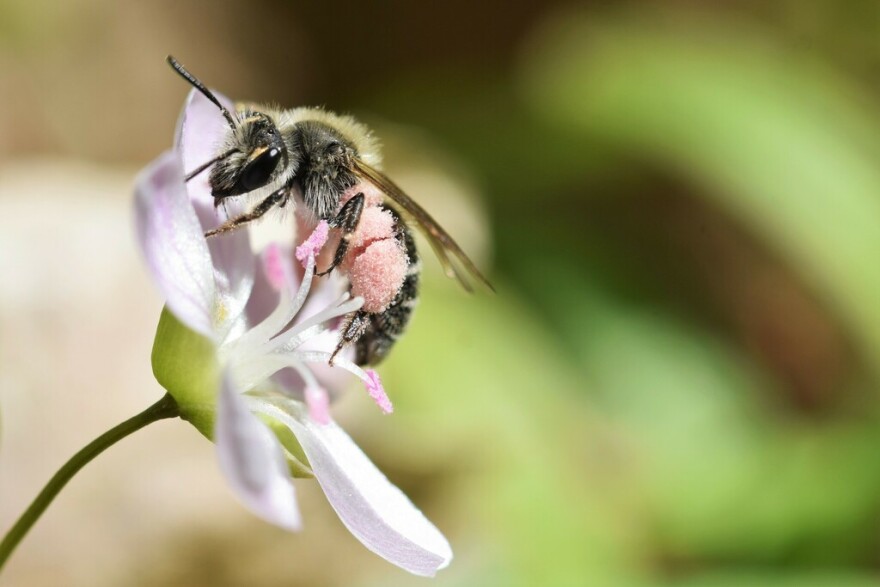What makes you so special(ist)?

Many of Minnesota’s native plants depend on just one or two species of bees to pollinate and reproduce. In turn, these bees’ larvae are fed exclusively on pollen from that specific plant species (this is called monolecty or oligolecty).
This highly interdependent relationship can exist between many plant and bee types, but is particularly common among spring ephemeral wildflowers and groups of bees called miner bees and sweat bees.
Some examples of bee-flower pairings are the spring beauty miner bee and the spring beauty wildflower, the trout-lily mining bee and trout lilies, and the pickerelweed long-horned bee and pickerelweed.
Some butterfly specialists include the northern blue, which is a specialist on dwarf blueberry, the Frigga fritillary, a specialist on bog willow, and the Freija fritillary which specializes on bog laurel.
Bee efficient
Bees are particularly efficient pollinators because they actively collect pollen to provision their nests. Female bees have specialized adaptations to carry pollen, and they have abundant ‘fur’ on their bodies which also gets covered in pollen. By carrying all this pollen from plant to plant, they greatly increase the odds of the plant becoming pollinated and being able to produce viable seeds.
That means both species are able to procreate: the bee by having well-fed larvae, and the plant by being able to produce seeds.
While other pollinators like butterflies, hummingbirds, and bats also assist plants with pollination, they do not actively harvest pollen and instead feed on the nectar.
That means the pollen they carry between plants is accidental- they do not harvest and transport it the way bees do- and their pollination rates are lower.
A nest, a cell, and an egg

These bees’ life cycles are very different from the more-familiar honeybee. Instead of living in hives, these bees are solitary: each female builds her own nest, forages for her own food, and equips her offspring with their own food supply. Most mining and sweat bees build nests in the ground, though some nest in wood.
Within the nest, each egg is laid in a cell with enough food to last it throughout its developmental period. Honey bees, in contrast, feed their larvae incrementally as they grow. Once a cell is provisioned with enough ‘bee bread’ (a combination of pollen and nectar), the mother lays an egg and closes the cell off to prevent predators from getting in. Then, she starts on the next cell.
These bees only produce one generation per year: these eggs will hatch, develop within their pre-provisioned cells (thanks, momma bee!), then emerge the next spring just in time to harvest the pollen from their preferred plant.
Mining and sweat bees also differ from honeybees and bumblebees in appearance. Though a few species are as large as a bumblebee, for the most part they are tiny (mosquito-sized to gnat-sized). They tend to be innocuous and harmless, and are unlikely to sting unless captured and provoked. (Furthermore, male bees don’t even have a stinger!)
Male bees are harder to find, because they don’t collect pollen and spend less time on flowers. Instead, they spend most of their time finding females.
What’s the buzz?
It’s unclear if these populations of specialist bees are decreasing. Many of these species have only recently been discovered (the current count of bee species in Minnesota is 508), and historical data on their population size isn’t available.
However, it is likely that these species are particularly at risk.
“We can think about these specialists as being perhaps more vulnerable to loss because they have this intimate relationship with the plant, and if the plant isn’t there, the bee will die,” stated Petersen. “It’s not like they can decide to have something else for dinner.”
If the bee somehow misses the blooming window for the plant, they’re out of luck. These bees only produce one generation per year, so there is no room for error.
To help the bees (and the scientists), Petersen encourages listeners to document bee sightings through community science apps like iNaturalist. Since these bees are quite small and inconspicuous, they tend to be unreported unless people actively seek them out.
“The more people that are out looking for these kinds of insects, the more insects we’ll find, and the more we’ll know about them and their relationships,” Petersen pointed out.
As always, the segment ends on a note of hope. “I know this segment is based on pollinator declines, but you know, there’s a lot of insects that are really capitalizing on a lot of the things happening in our environment too. So, there’s some loss and some great gains, and there’s still a lot out there for us to learn,” said Petersen.
“So, get out there and take pictures and enjoy the insects!”
Funding for this project was provided by the Minnesota Environment and Natural Resources Trust Fund as recommended by the Legislative-Citizen Commission on Minnesota Resources (LCCMR).








